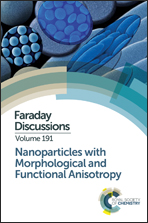Anisotropic surface functionalization of Au nanorods driven by molecular architecture and curvature effects†
Abstract
This work suggests a novel strategy to coat the caps and body of Au-nanorods (Au-NRs) with end-grafted polymer layers of different compositions by taking advantage of the different curvature of these two regions. A molecular theory was used to theoretically investigate the effect of local curvature and molecular architecture (intramolecular connectivity of the monomers) on the adsorption of polymer mixtures on cylindrical (Au-NR body) and spherical (Au-NR caps) surfaces. The adsorption process was systematically studied as a function of the backbone length, number and position of branches, quality of the solvent and total number of monomers of the polymer molecules in the mixture. The balance between repulsive forces and polymer–surface and polymer–polymer attractions governs the amount and composition of the adsorbed layer. This balance is in turn modulated by the architecture of the polymers, the curvature of the surface and the competition between the different polymers in the mixture for the available area. As a result, the equilibrium composition of the polymer layer on spheres and cylinders of the same radius differs, and in turn departs from that of the bulk solution. Curvature plays a major role: the available volume at a given distance from the surface is larger for spherical surfaces than for cylindrical ones, therefore the surface density of the bulkier (more branched) polymer in the mixture is larger on the Au-NR caps than on the Au-NR body. These results suggest that the combination of curvature at the nanoscale and tailored molecular architecture can confer anisotropic nanoparticles with spatially enriched domains and, therefore, lead to nanoconstructs with directional chemical interactions.
- This article is part of the themed collection: Nanoparticles with Morphological and Functional Anisotropy

 Please wait while we load your content...
Please wait while we load your content...